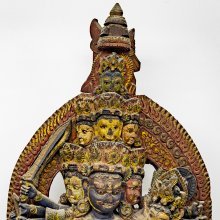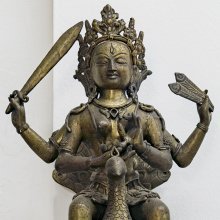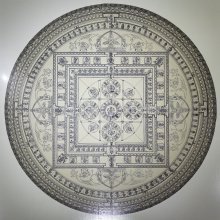Kaumari, Kaumārī: 16 definitions
Introduction:
Kaumari means something in Buddhism, Pali, Hinduism, Sanskrit, biology, Tamil. If you want to know the exact meaning, history, etymology or English translation of this term then check out the descriptions on this page. Add your comment or reference to a book if you want to contribute to this summary article.
Images (photo gallery)
In Hinduism
Shaktism (Shakta philosophy)
Source: Wisdom Library: Śāktism1) Kaumārī (कौमारी) refers to the fifth of the eight Aṣṭamātṛkā (mother Goddesses) of Kathmandu city, locally known as Lumadhi Ajimā. Her location is Bhadrakālī.
2) Kaumārī (कौमारी) refers to “juvenile, childhood, youtful” and represents one of the sixty-four mātṛs to be worshipped during Āvaraṇapūjā (“Worship of the Circuit of Goddesses”, or “Durgā’s Retinue”), according to the Durgāpūjātattva. They should be worshipped with either the five upācāras or perfume and flowers.
Her mantra is as follows:
Source: Google Books: Manthanabhairavatantramॐ कौमार्यै नमः
oṃ kaumāryai namaḥ.
1) Kaumārī (कौमारी) is the name of a Mātṛkā (‘mother’) and is identified with the sacred site of Kollā, according to the Manthānabhairavatantra, a vast sprawling work that belongs to a corpus of Tantric texts concerned with the worship of the goddess Kubjikā.—According to the Kubjikā Tantras, the eight major Kaula sacred sites each have a house occupied by a woman of low caste who is identified with a Mother (Mātṛkā).—[...] Kollā is identified with (a) the class of fisherwoman (kaivartī) [or butcher woman (saunī)], (b) the Mātṛkā or ‘mother’ named Kaumārī, and (c) with the location of ‘throat’.
2) Kaumārī (कौमारी) refers to a “young virgin”, according to the Ṭīkā (commentary) on the Manthānabhairavatantra.—Accordingly, “[...] The consort of the Great Tree, that is, the incarnation Ṣaṣṭhanātha is (the goddess) Maṅgalā. She is crooked and (resides) in the place of the six-faced Siddha namely, in Suṣumṇā, the middle channel. How is she? She is a beautiful, young virgin (kaumārī). What is meant by this is that she is skillful in doing all things. It is for this reason that it is said that (she is) Kuṇḍalinī as the Middle Lineage between that of the Eldest and the Youngest and is associated with both. [...]”.
Source: Sreenivasarao's blog: Saptamatrka (part 4)Kaumari refers to one of the seven mother-like goddesses (Matrika).—The Matrikas emerge as shaktis from out of the bodies of the gods: Kaumari from Skanda. The order of the Saptamatrka usually begins with Brahmi symbolizing creation. Then, Vaishnavi and Maheshvari. Then, Kaumari, Guru-guha, the intimate guide in the cave of one’s heart, inspires aspirations to develop and evolve. Kaumari is also known as Kumari, Karttikeyani and Ambika.
The Bhavanopanishad (9) recognizes Matrikas as eight types of un-favourable dispositions, such as: desire, anger, greed, delusion, pride, jealousy, demerit and merit. Tantra-raja-tantra (36; 15-16) expands on that and identifies Kaumari with youthful longings to enjoy (lobha).
According to Khadgamala (vamachara) tradition of Sri Vidya, the eight Matrkas are located along the wall (four at the doors and four at the corners) guarding the city (Tripura) on all eight directions: Kaumari on the East.
Source: Kamakoti Mandali: The Yoginis of Narasimha VyuhaKaumārī (कौमारी) is the name of a Mātṛkā-Śakti created by Mahārudra in order to control the plague of demons created by Andhakāsura.—Accordingly, Andhaka-Asura tried to kidnap Umā (Devī Pārvatī), and was fiercely attacked by Mahārudra who shot arrows at him from his mahāpināka. when the arrows pierced the body of Andhakāsura, drops of blood fell to earth and from those drops, thousands of Andhakas arose. To control this plague of demons, Mahārudra created Mātṛkā-Śaktis [viz., Kaumārī] and ordered them to drink the blood of the demons and drain them dry.
Source: Kamakoti Mandali: Nrisimha matrika-mandalaKaumārī (कौमारी) refers to one of the various Mātṛkā-Śaktis created by Rudra in order to destroy the clones that spawned from Andhaka’s body.—Accordingly, [...] Andhakāsura attempted to abduct Girājanandinī (Pārvatī) and thus ensued a fierce battle between Andhakāsura and the great Rudra, the Lord of Umā. Like raktabīja, every drop of blood that fell from the body of Andhaka created another Asura like him and in no time, the entire world was filled with Andhakas. To destroy the growing number of Andhakas, Rudra created innumerable Mātṛkā-Śaktis [viz., Kaumārī]. These Śaktis of immense power at once began to drink every drop of blood that flowed from the body of Andhaka, but they could still not effectively contain the emergence of more and more demons.

Shakta (शाक्त, śākta) or Shaktism (śāktism) represents a tradition of Hinduism where the Goddess (Devi) is revered and worshipped. Shakta literature includes a range of scriptures, including various Agamas and Tantras, although its roots may be traced back to the Vedas.
Purana and Itihasa (epic history)
Source: Wisdom Library: The Matsya-purāṇaKaumārī (कौमारी) is the name of a mind-born ‘divine mother’ (mātṛ), created for the purpose of drinking the blood of the Andhaka demons, according to the Matsya-purāṇa 179.8. The Andhaka demons spawned out of every drop of blood spilled from the original Andhakāsura (Andhaka-demon). According to the Matsya-purāṇa 179.35, “Most terrible they (e.g., Kaumārī) all drank the blood of those Andhakas and become exceedingly satiated.”
The Matsyapurāṇa is categorised as a Mahāpurāṇa, and was originally composed of 20,000 metrical verses, dating from the 1st-millennium BCE. The narrator is Matsya, one of the ten major avatars of Viṣṇu.
Source: Cologne Digital Sanskrit Dictionaries: The Purana Index1a) Kaumārī (कौमारी).—A śaktī.*
- * Brahmāṇḍa-purāṇa IV. 19. 7; 36. 58; 44. 111.
1b) A mind-born mother; image of; the chief implements and adornment follow that of Kumāra; the peacock for the riding animal, clad in red robes and wielding śūla and śakti.*
- * Matsya-purāṇa 179. 9, 22; 261. 27.

The Purana (पुराण, purāṇas) refers to Sanskrit literature preserving ancient India’s vast cultural history, including historical legends, religious ceremonies, various arts and sciences. The eighteen mahapuranas total over 400,000 shlokas (metrical couplets) and date to at least several centuries BCE.
Shilpashastra (iconography)
Source: Sreenivasarao's blog: Saptamatrka (part 4) (shilpa)Kaumari refers to the fourth Matrka and is the shakthi of Kumara or Skanda (the war-god). Her depictions resemble that of Kumara. She is ever youthful, representing aspirations in life. Kaumari is also regarded as Guru-Guha the intimate guide who resides in the cave of one’s heart. She is shown seated under a fig tree (Oudumbara) riding a peacock, which is also her emblem. Her complexion is golden yellow; and is dressed in red garments. She wears garland of red flowers. Kaumari has four hands; and carries shakti and kukkuta (cockerel) or ankusha (goad). The other two hands gesture Abhaya and Varada mudras. She is adorned with a makuta said to be bound with vasika or vachika. She embodies ideas of valour and courage. (Purvakaranagama and Devi Purana).
According to the Vishnudharmottara, Kaumari should be shown with six faces and twelve arms; two of her hands gesturing Abhaya and Varada mudras. In her other hands she carries the shakti, dhvaja, danda, dhanus, bana, ghanta, padma, patra and parasu. Each of her heads has three eyes; and is adorned with karanda-makuta.

Shilpashastra (शिल्पशास्त्र, śilpaśāstra) represents the ancient Indian science (shastra) of creative arts (shilpa) such as sculpture, iconography and painting. Closely related to Vastushastra (architecture), they often share the same literature.
Shaivism (Shaiva philosophy)
Source: Brill: Śaivism and the Tantric TraditionsKaumārī (कौमारी) (seed-syllable: a) refers to one of the eight Mother-goddesses (Mātṛs) of the pantheon of Mantra-deities, according to the Brahmayāmala-tantra (or Picumata), an early 7th century Śaiva text consisting of twelve-thousand verses.—Patterning the processes of inner and outer ritual is the Brahmayāmala’s pantheon of mantra-deities, whose core comprises the Four Goddesses or Guhyakās, Four Consorts or Handmaidens, and their lord, Kapālīśabhairava. Secondary members of the pantheon are a sextet of Yoginīs and an octad of Mother-goddesses [e.g., Kaumārī].

Shaiva (शैव, śaiva) or Shaivism (śaivism) represents a tradition of Hinduism worshiping Shiva as the supreme being. Closely related to Shaktism, Shaiva literature includes a range of scriptures, including Tantras, while the root of this tradition may be traced back to the ancient Vedas.
In Buddhism
Tibetan Buddhism (Vajrayana or tantric Buddhism)
Source: Wisdom Library: Tibetan BuddhismKaumārī (कौमारी) refers to one of the various Mātṛs and Mahāmātṛs mentioned as attending the teachings in the 6th century Mañjuśrīmūlakalpa: one of the largest Kriyā Tantras devoted to Mañjuśrī (the Bodhisattva of wisdom) representing an encyclopedia of knowledge primarily concerned with ritualistic elements in Buddhism. The teachings in this text originate from Mañjuśrī and were taught to and by Buddha Śākyamuni in the presence of a large audience (including Kaumārī).
Source: Google Books: An Esoteric Exposition of the Bardo Thodol Part AKaumārī (कौमारी):—One of the six Īśvarī performing the rites of pacification.—The counterpart of this pair is Indrāṇī..
Source: academia.edu: The Structure and Meanings of the Heruka MaṇḍalaKaumārī (कौमारी) refers to the Ḍākinī of the western gate in the Medinīcakra, according to the 10th century Ḍākārṇava chapter 15. Accordingly, the medinīcakra refers to one of the three divisions of the dharma-puṭa (‘dharma layer’), situated in the Herukamaṇḍala. The four gate Ḍākinīs [viz., Kaumārī] each has the same physical feature as the four Ḍākinīs starting with Lāmā.
Source: OSU Press: Cakrasamvara SamadhiKaumārī (कौमारी) is the name of a deity [i.e., oṃ kaumāryai svāhā], according to the Vāruṇī Pūjā [i.e., Varuni Worship] ritual often performed in combination with the Cakrasaṃvara Samādhi, which refers to the primary pūjā and sādhanā practice of Newah Mahāyāna-Vajrayāna Buddhists in Nepal.

Tibetan Buddhism includes schools such as Nyingma, Kadampa, Kagyu and Gelug. Their primary canon of literature is divided in two broad categories: The Kangyur, which consists of Buddha’s words, and the Tengyur, which includes commentaries from various sources. Esotericism and tantra techniques (vajrayāna) are collected indepently.
Biology (plants and animals)
Source: Google Books: CRC World Dictionary (Regional names)Kaumari in India is the name of a plant defined with Anamirta cocculus in various botanical sources. This page contains potential references in Ayurveda, modern medicine, and other folk traditions or local practices It has the synonym Menispermum lacunosum Lam. (among others).
Example references for further research on medicinal uses or toxicity (see latin names for full list):
· Systema Naturae (1817)
· Taxon (1979)
· Species Plantarum (1753)
· Transactions of the Linnean Society of London (1821)
· Kew Bulletin (1978)
· Prodr. Flora Indica, or ‘Descriptions of Indian Plants’ Orient. (1834)
If you are looking for specific details regarding Kaumari, for example extract dosage, health benefits, pregnancy safety, side effects, diet and recipes, chemical composition, have a look at these references.

This sections includes definitions from the five kingdoms of living things: Animals, Plants, Fungi, Protists and Monera. It will include both the official binomial nomenclature (scientific names usually in Latin) as well as regional spellings and variants.
Languages of India and abroad
Sanskrit dictionary
Source: Cologne Digital Sanskrit Dictionaries: Monier-Williams Sanskrit-English Dictionary1) Kaumārī (कौमारी):—[from kaumāra] f. one of the seven Mātṛs or personified energies of the gods, Śakti of Kumāra or Kārttikeya (the god of war), [Brahma-purāṇa] [Devī-bhāgavata-purāṇa]
2) [v.s. ...] a kind of bulbous root (= vārāhī-kanda), [cf. Lexicographers, esp. such as amarasiṃha, halāyudha, hemacandra, etc.]
3) [v.s. ...] (in music) Name of a Rāgiṇī
Sanskrit, also spelled संस्कृतम् (saṃskṛtam), is an ancient language of India commonly seen as the grandmother of the Indo-European language family (even English!). Closely allied with Prakrit and Pali, Sanskrit is more exhaustive in both grammar and terms and has the most extensive collection of literature in the world, greatly surpassing its sister-languages Greek and Latin.
Kannada-English dictionary
Source: Alar: Kannada-English corpusKaumāri (ಕೌಮಾರಿ):—
1) [noun] a girl or a woman not having sexual intercourse; a virgin.
2) [noun] one of the seven divine mothers (all of whom are considered as partial incarnation of Pārvati).
3) [noun] the regent goddess of the third musical note 'gāndhāra'.
Kannada is a Dravidian language (as opposed to the Indo-European language family) mainly spoken in the southwestern region of India.
See also (Relevant definitions)
Starts with: Kaumari shanti, Kaumarika, Kaumarikakhanda, Kaumarikatantra, Kaumarikeya, Kaumarila, Kaumaripauriki, Kaumaritantra, Kaumaritva.
Ends with: Divyakaumari, Vrindakaumari.
Full-text (+25): Ashtamatrika, Matri, Saptamatri, Indrani, Karttikeyani, Ambika, Kumari, Kaumara, Saptamatrika, Kaumari shanti, Saptamatrike, Matrika, Sauni, Shakri, Mahendri, Cattamatar, Kulagiri, Aindri, Vajrin, Kollagiri.
Relevant text
Search found 28 books and stories containing Kaumari, Kaumārī, Kaumāri; (plurals include: Kaumaris, Kaumārīs, Kaumāris). You can also click to the full overview containing English textual excerpts. Below are direct links for the most relevant articles:
Temples of Munnur (Historical Study) (by R. Muthuraman)
The Garuda Purana (by Manmatha Nath Dutt)
Chapter XXIV - The worship of Ganapati < [Agastya Samhita]
Chapter CXXXIV - Maha Kausika Vratas etc < [Brihaspati (Nitisara) Samhita]
Chapter CCXXIII - The Tripura Vidya < [Dhanvantari Samhita]
Varahi Tantra (English Study) (by Roberta Pamio)
Chapter 29 - The worship of Caṇḍikā < [Summary of the Vārāhī Tantra]
The Goddess Vārāhī (Introduction)
Chapter 14 - The worship of Caṇḍī < [Summary of the Vārāhī Tantra]
Puranic encyclopaedia (by Vettam Mani)
Nitiprakasika (Critical Analysis) (by S. Anusha)
Asidhenu (Stiletto) < [Chapter 3]
The Devi Bhagavata Purana (by Swami Vijñanananda)
Related products





